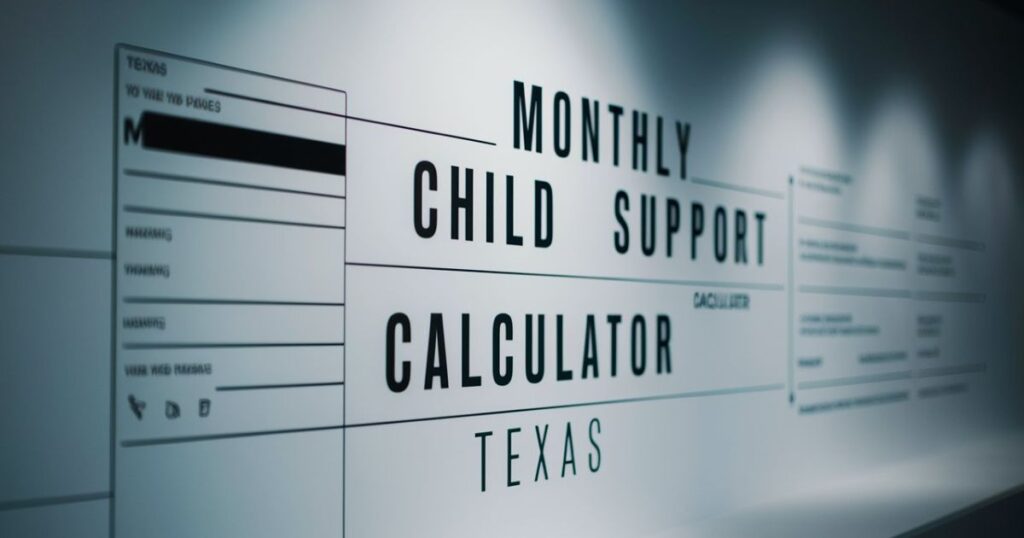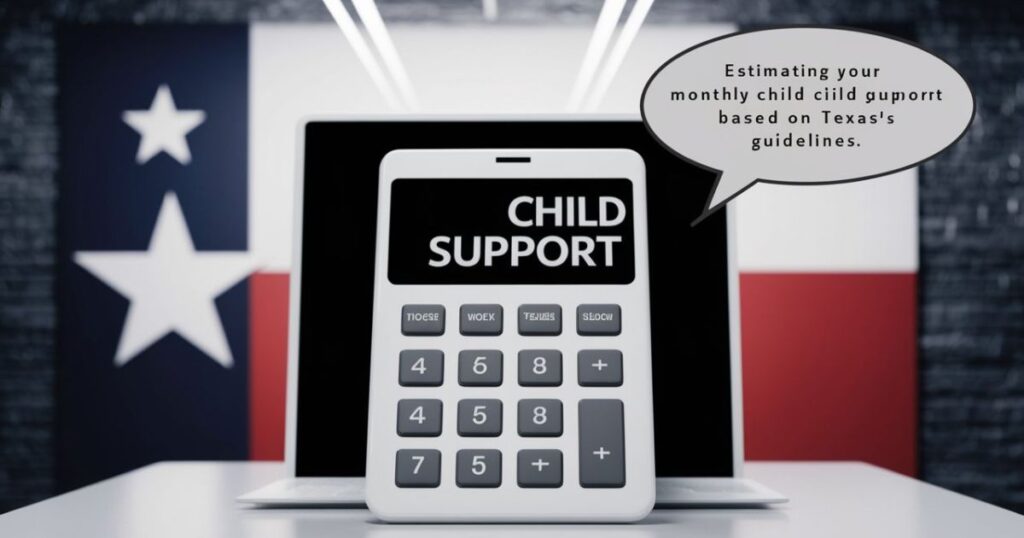Determining child support payments is a critical aspect of divorce proceedings, especially when children are involved. In Texas, the process of calculating child support is governed by specific state laws and guidelines.
This comprehensive guide will walk you through the intricacies of calculating child support payments, considering various factors such as income, custody arrangements, and state regulations. We’ll also explore different scenarios and provide examples to help you better understand the process.
Child Custody Schedules In Texas Divorce
The amount of child support owed is directly influenced by the custody arrangement established during the divorce. In Texas, there are two main custody scenarios:
- Sole Custody: When one parent has the exclusive right to determine the child’s primary residence, and the other parent has visitation rights.
- Joint Custody: Both parents share the rights and responsibilities of raising the child, and the child’s time is divided between the two households.
The child support calculations differ based on the custody schedule, with joint custody generally resulting in a lower payment amount than sole custody.
Monthly Child Support Calculator For Texas

The State of Texas provides an official child support calculator to assist parents in estimating their monthly child support obligations. This calculator considers various factors, including:
- The monthly net resources (income) of both parents
- The number of children involved
- The cost of healthcare premiums and childcare expenses
- The amount of time each parent spends with the child(ren)
Using this calculator can provide an initial estimate, but it’s essential to consult with a qualified legal professional to ensure accuracy and compliance with the most recent guidelines.
Child Support Calculator Texas 2023
The Texas child support guidelines are subject to periodic updates and revisions. In 2023, there were specific changes to the guidelines, including:
- Adjustments to the recommended support amounts based on the cost of living and income levels
- Modifications to the calculation of net resources (income) for self-employed individuals
- Revised guidelines for parents with multiple households and children from different relationships
It’s crucial to stay informed about the latest updates to ensure accurate calculations and compliance with the current laws.
Read This Interesting Post: Shaping Success: The Inspiring Journey Of Brook B. Taube In The Finance Industry
How Much Is Child Support In Texas?
What Is Considered Income For Child Support?
In Texas, both parents’ income is taken into account when calculating child support payments. Income is categorized as either gross resources (income) or net resources (income).
Gross Resources (Income)
Gross resources (income) include various sources of income, such as:
- Wages, salaries, commissions, and tips
- Self-employment income
- Bonuses and overtime pay
- Interest and dividend income
- Rental income
- Retirement or disability benefits
- Unemployment compensation
- Spousal maintenance (alimony) received
Net Resources (Income)
To determine the net resources (income), certain deductions are permitted from the gross resources (income). These deductions may include:
- Federal income tax
- State income tax
- Social Security and Medicare taxes
- Union dues
- Health insurance premiums for the children
- Subsequent spouse’s income (in some cases)
It’s important to note that the calculation of net resources (income) can vary depending on individual circumstances and the specific guidelines in effect at the time of the calculation.
If I Make $1,000 A Week How Much Child Support Do I Pay

Let’s consider an example where the parent’s weekly income is $1,000 (approximately $52,000 annually). Assuming they have one child and the other parent’s income is negligible, the estimated child support payment would be around $249 per month.
This amount is based on the Texas guidelines, which recommend a payment of approximately 20% of the parent’s net resources for one child.
If I Make $60,000 A Year How Much Child Support
For a parent earning $60,000 annually with one child, the estimated child support payment would be approximately $900 per month.
This estimation is based on the Texas guidelines, which recommend a payment of 20% of the parent’s net resources for one child, after accounting for deductions such as taxes and healthcare premiums.
If I Make $500 A Week How Much Child Support Do I Pay
In the case of a parent earning $500 per week (approximately $26,000 annually) with one child, the estimated child support payment would be around $156 per month.
This amount is calculated based on the Texas guidelines, which recommend a payment of approximately 20% of the parent’s net resources for one child in this income range.
The Calculator Below Will Estimate Your Monthly Child Support Payment Based On Texas’s Child Support Guidelines.

To assist you in estimating your potential child support payments, we’ve embedded the official Texas child support calculator here:
Texas Child Support Calculator
Please note that this calculator provides an estimate based on the information you input. For an accurate determination of your child support obligations, it’s recommended to consult with a qualified legal professional.
Instructions for using the calculator:
- Enter the monthly net resources (income) for both parents.
- Indicate the number of children involved.
- Provide information about healthcare premiums and childcare expenses.
- Specify the custody arrangement and the percentage of time each parent spends with the child(ren).
- Submit the information, and the calculator will provide an estimated monthly child support payment.
Three-Year Review
In Texas, child support orders are subject to a mandatory review every three years. During this review, the court may modify the existing order based on changes in circumstances, such as:
- Significant changes in either parent’s income
- Changes in the child’s medical or educational needs
- Adjustments to the cost of living or state guidelines
It’s essential to be prepared for this review and to provide updated financial information to ensure that the child support payments remain fair and appropriate for the current situation.
Download A Free Resource, Stay Protected During Divorce
Going through a divorce can be an emotionally and financially challenging process, especially when children are involved. To help you navigate this journey, we’ve prepared a free downloadable resource: “Protecting Your Child’s Best Interests During Divorce.”
This comprehensive guide offers valuable insights and practical advice on:
- Understanding child support laws and guidelines in Texas
- Ensuring fair and accurate child support calculations
- Addressing common challenges and disputes
- Maintaining a healthy co-parenting relationship
By equipping yourself with this valuable information, you can better advocate for your child’s well-being and protect their financial security during and after the divorce process.
Thinking About Divorce? Book A Free Call
If you’re considering divorce or have questions about child support, we encourage you to schedule a free consultation with one of our experienced family law attorneys. During this call, you’ll have the opportunity to discuss your specific situation, address any concerns, and receive personalized guidance on the next steps.
Our team is committed to providing compassionate support and effective legal representation to ensure the best possible outcome for you and your children.
Child Support Guidelines In Texas
Standard Child Support In Texas Guidelines
The standard child support guidelines in Texas are based on a percentage of the parent’s net resources (income). The percentages are as follows:
- One child: 20% of the parent’s net resources
- Two children: 25% of the parent’s net resources
- Three children: 30% of the parent’s net resources
- Four children: 35% of the parent’s net resources
- Five children: 40% of the parent’s net resources
- Six or more children: No less than the amount for five children
These percentages are applied to the parent’s net resources up to a specific cap, which is adjusted periodically based on the cost of living and other factors.
What Are The Low-Income Child Support Guidelines?
For parents with limited financial resources, Texas has alternative guidelines for low-income situations. These guidelines aim to ensure that child support payments are fair and manageable for both parents.
The low-income guidelines consider various factors, such as:
- The parents’ combined net resources
- The number of children involved
- The cost of healthcare premiums and childcare expenses
In some cases, the low-income guidelines may result in a lower child support payment amount than the standard guidelines.
How Will My Child Support Payments Affect My Ability To Take Out A Mortgage?
Child support payments can impact your ability to qualify for a mortgage or other types of financing. Lenders typically consider child support payments as a recurring monthly obligation, similar to other debts or expenses.
When evaluating your mortgage application, lenders will calculate your debt-to-income ratio (DTI), which compares your total monthly debts (including child support) to your gross monthly income. A higher DTI may make it more challenging to qualify for a mortgage or secure favorable interest rates.
Does It Count As Debt, If I Pay Child Support?
When it comes to determining your eligibility for loans, mortgages, or other forms of financing, child support payments are generally treated as a recurring monthly obligation, similar to other types of debt.
Lenders typically categorize child support payments as a fixed expense, along with items like car payments, student loans, and credit card balances. These obligations are factored into your debt-to-income ratio (DTI), which is a critical metric used to assess your ability to manage additional credit or loan payments.
While child support payments are not considered debt in the traditional sense, they can impact your overall debt burden and creditworthiness in the eyes of lenders. Failure to make court-ordered child support payments can also have negative consequences, such as garnished wages, tax refund interceptions, or even legal action.
It’s crucial to maintain a consistent record of timely child support payments to demonstrate financial responsibility and avoid potential issues when seeking financing or credit in the future.
Computing Support For Children In More Than One Household

In situations where a parent has children from multiple relationships, the child support calculation becomes more complex. Texas follows specific guidelines for determining support obligations when there are children in more than one household.
The process typically involves:
- Calculating the parent’s net resources: This includes their income from all sources, minus allowable deductions.
- Determining the support amount for each household: The appropriate percentage (based on the number of children in each household) is applied to the parent’s net resources to calculate the support amount for each household.
- Allocating the support amount across households: The total support amount is then divided proportionally among the households, based on the number of children in each household.
This approach ensures that all children receive an appropriate level of support, while also considering the parent’s overall financial obligations.
Thinking About The House? Keeping Your Current Home Through A Buyout
During a divorce, deciding what to do with the family home can be a challenging decision. One option to consider is a “buyout,” where one spouse purchases the other’s share of the home’s equity.
A buyout can be a viable solution if one spouse wishes to remain in the home, particularly if the children will continue living there. It can provide stability and minimize disruption for the children during an already tumultuous time.
However, a buyout requires careful consideration of various factors, such as:
- The current market value of the home
- The amount of equity each spouse has in the property
- The ability to qualify for a mortgage or refinancing to buy out the other spouse’s share
It’s recommended to consult with a qualified real estate professional and a financial advisor to determine the feasibility and potential implications of a buyout.
What Is Your Home Worth Today?
If you’re considering a buyout or evaluating your options regarding the family home during a divorce, it’s essential to have an accurate understanding of your home’s current market value.
Obtaining a Comparative Market Analysis (CMA) from a real estate professional can provide valuable insights into your home’s worth based on recent sales of similar properties in your area.
A CMA takes into account various factors, including:
- Location and neighborhood
- Size and condition of the property
- Number of bedrooms and bathrooms
- Amenities and upgrades
- Current market trends and demand
Armed with this information, you can make informed decisions about your home and negotiate more effectively during the divorce process.
Do I Need A CMA?
A Comparative Market Analysis (CMA) is a valuable tool when navigating the complexities of divorce and property division. Even if you’re not planning to sell your home immediately, a CMA can provide crucial information to help you:
- Determine the fair market value of your home
- Understand your equity position and potential buyout scenarios
- Negotiate effectively with your spouse or their legal representatives
- Make informed decisions about your living situation and financial future
Obtaining a CMA from a reputable real estate professional is highly recommended, as it can offer an objective and data-driven assessment of your home’s worth in the current market.
Remember, knowledge is power, and having accurate information about your home’s value can significantly impact the outcome of your divorce settlement.
You May Also Like This Post: How To Open A Coin Laundry Business
Conclusion
Calculating child support payments in Texas can be a complex process, involving various factors such as income, custody arrangements, and state guidelines. By understanding the nuances of the child support system and seeking professional guidance, you can ensure that your child’s financial needs are met in a fair and equitable manner.
It’s crucial to stay informed about the latest updates and changes to the Texas child support guidelines, as well as to be proactive in addressing any modifications that may arise due to changes in circumstances.
Remember, the well-being and financial security of your children should be the top priority throughout the divorce process. By following the guidelines outlined in this comprehensive guide and seeking the assistance of qualified legal and financial professionals, you can navigate the complexities of child support calculations with confidence.
Frequently Ask Question
How much do most dads pay in child support?
Child support payments vary widely based on factors like income, custody arrangements, and state guidelines.
How is child support calculated in the US?
Child support is typically calculated based on income, the number of children, and other factors outlined in state-specific guidelines.
How much is child support for 2 kids in Texas?
Child support in Texas for two children is usually a percentage of the non-custodial parent’s income, determined by state guidelines.
How much is child support in California with 50/50 custody?
Child support in California with 50/50 custody may still be required based on each parent’s income and the specific custody arrangement.
What is the maximum amount of child support that can be taken?
The maximum amount of child support varies by state and is typically determined by state guidelines and the income of the paying parent.
How does California calculate child support?
California calculates child support based on each parent’s income, the amount of time each parent spends with the child, and other factors outlined in state guidelines.
How is child support generally calculated?
Child support is typically calculated based on factors such as income, the number of children, childcare expenses, and healthcare costs.
What factors determine child support payments?
Factors determining child support payments include income, custody arrangements, the child’s needs, and any special circumstances.
Can child support be modified if circumstances change?
Yes, child support can be modified if there are significant changes in circumstances such as income, custody arrangements, or the child’s needs.
What is the difference between sole and joint custody for child support?
Sole custody typically involves one parent having primary physical and legal custody, while joint custody involves both parents sharing physical and/or legal custody, which can impact child support calculations.
How long do I have to pay child support?
Child support obligations typically end when the child reaches the age of majority, graduates from high school, or becomes emancipated, as determined by state law and any specific agreements.







